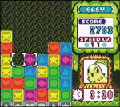
 |
|
Pokémon Puzzle Challenge is Pokémon Puzzle League...almost. Aside from a few minor changes, Pokémon Puzzle Challenge (PPC) is one of the most faithful SNES (Tetris Attack) to N64 (Pokémon Puzzle League) to Game Boy Color ports available. As Martha Stewart would say: "It’s a good thing." The concept of PPC is simple enough: line up three blocks of the same color in order to destroy them. The player moves her cursor to any two side-by-side blocks and switch them with a press of the button; likewise the cursor can also be used to switch one block with an empty space. Though it may come as a total shocker, Nintendo has chosen to include gravity in the game, causing blocks with nothing below them fall to the bottom of the screen. Meanwhile, new blocks appear on the bottom of the screen, the speed of which depends on the difficulty level. The different modes of the game (most of which are exact replicas of their N64 counterparts) are all permutations of these rules.
Marathon, Time Zone, and Garbage modes all share a common goal: to get the highest score possible. Marathon is played until blocks fill up the entire screen. This can quite literally take hours to happen even for the novice player since the severity of the levels creeps up so slowly. Time Zone gives the player two minutes to make as many combos and chains as possible. Garbage, like Marathon, is played until blocks fill the screen and it can take just as long to happen. The only difference is that a ghost opponent drops solid blocks of nothing that must be turned into regular blocks. Yet another single player mode, Line Clear, requires all blocks above a certain line to be cleared in order to move up to a higher stage. In Challenge mode, it is no longer merely enough to get three-block combos to beat the computer. Four-block or higher combos, as well as two or more chains, are needed to get the enemy’s health bar below zero. The health bar of the opponent (on the right side of the screen) begins as full at the beginning of the battle and slowly decreases as the player makes any special block formation. When the bar is emptied completely, the opponent’s Pokémon "faints" and the next level is accessible. This mode also has an added feature that PPL did not: rare "exclamation" blocks have been added which cause damage even if only three blocks are put together. Those dissatisfied with the never-ending Marathon mode will be quite happy with the higher levels of Challenge mode. Unfortunately it can take just as much time to beat some of the final opponents. Players will find themselves continuing hundreds of times (the game very thoughtfully keeps track of your failures) in order to defeat the final Pokémaster, but the final victory is all the more satisfying. The Puzzle mode, possibly the best feature of PPC, may be very familiar in substance and difficulty to those who have played the Puzzle mode in the PlayStation game Devil Dice. Players are given a set scenario and a set number of moves to get rid of all the blocks on the screen. The only real drawback to Puzzle mode is its extreme difficulty. Gamers will likely find themselves referring to a strategy guide to solve all of the puzzles after the first thirty or so rounds. Usually finding the first move in a strategy guide or by using one of your allotted hints brings the difficulty level back to the realm of sanity.
For gamers with friends there is the nice option of Two Player Versus, an overall enjoyable mode with just a few minor drawbacks. Versus mode lacks the intensity of the N64 version because it is not possible to see the opponent’s screen. Thus, is exactly like playing the computer. PPC just doesn’t create the intense party game atmosphere of Pokémon Puzzle League. Still, having the option of playing with another is still an added bonus; after all, it could have been left off entirely. One mode that has been omitted from the GBC version is the 3D mode. Luckily this mode was only a trifle anyway and did not allow the player to plan any strategies. It involved random chipping at the wall of blocks, which was circular and four times bigger. Those familiar with the N64 version won’t find themselves missing the mode. For those new to the game: what you don’t know can’t hurt you. With all of this talk about disappearing blocks, one may wonder when the Pokémon actually come into play. When it comes down to it, the only function the Pokémon have in actual gameplay is their use as continues. Every time a player loses a round, she loses a Pokémon. Thus, players with more Pokémon have more continues. However, this is rendered useless by the addition of unlimited continues which are available the very first time and every time all the Pokémon have fainted. Other than that, the Pokémon are just around to look cute. Thankfully, the sound effects of Pokémon are not as prevalent as in the N64 version, so those who are simply looking for a good GBC puzzle game can play the game without getting too incredibly annoyed by the Pokémon contained within. Much like Dance Dance Revolution Disney Mix, Pokémon Puzzle Challenge is an example of a solid game that has corporate sponsorship and all the hype that goes along with it. Though the Pokémon may drive some away, what lies behind the cute collectable monster facade is a well-designed puzzle game. On the whole, it is a welcome addition to any gamer’s Game Boy puzzle library. Retrospective by S. Kennedy, Freelance. |
|
|||||||||||||||||||||||||||||||||||||||||||


